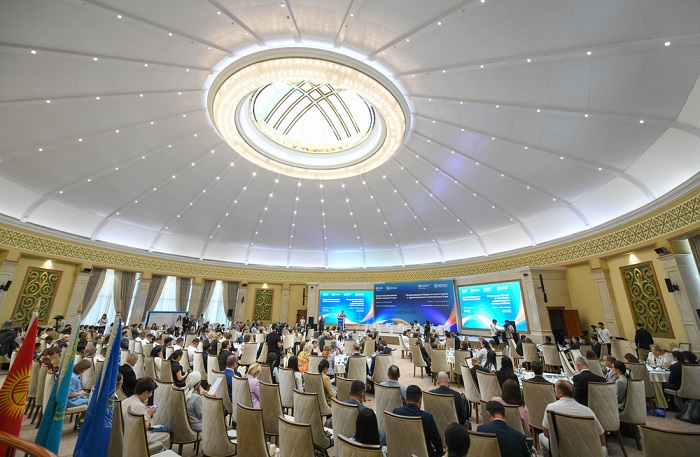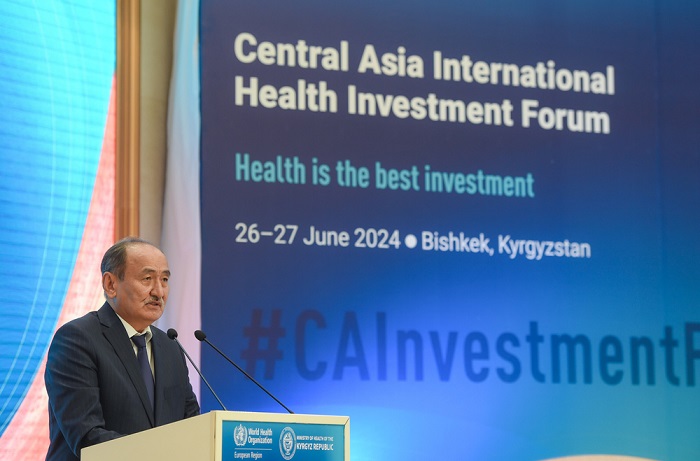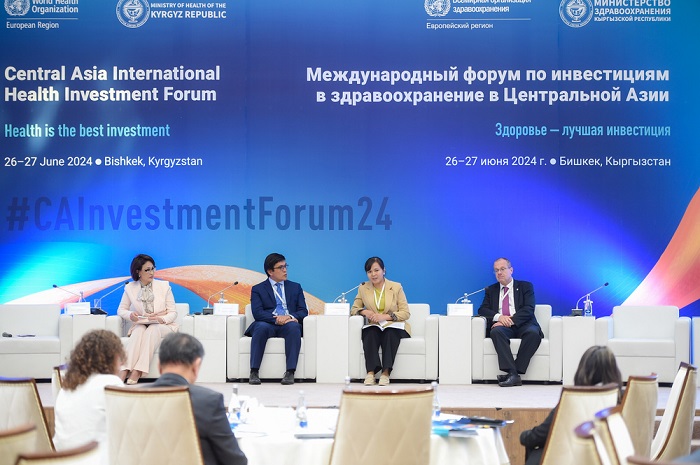 Bishkek, Kyrgyzstan, 26 June 2024 – Under the motto “Health is the best investment”, the first-ever Central Asia International Health Investment Forum is bringing together international, regional and national stakeholders to highlight the transformative potential of health investments for sustainable development across the 5 WHO Member States of Central Asia.
Bishkek, Kyrgyzstan, 26 June 2024 – Under the motto “Health is the best investment”, the first-ever Central Asia International Health Investment Forum is bringing together international, regional and national stakeholders to highlight the transformative potential of health investments for sustainable development across the 5 WHO Member States of Central Asia.
Hosted under the patronage of the President of the Kyrgyz Republic and organized by the WHO Regional Office for Europe and the Ministry of Health of the Kyrgyz Republic, this two-day event aims to showcase best practices and innovative health investment strategies that align with the Sustainable Development Goals (SDGs), for example through public-private partnerships or the use of digital health tools to improve efficiency.
 At the Forum, Dr Hans Henri P. Kluge, WHO Regional Director for Europe, commented, “There’s a reason that we are here, in the heart of Central Asia. While the rest of the WHO European Region is rapidly ageing, this region has a significant young and educated population – with roughly half of people under the age of 30. This will – if the youth potential is maximized – give Central Asia an edge in the decades ahead. Meanwhile, economic growth remains solid. GDP overall is expected to increase by 4.1% this year, higher than any other part of the WHO European Region. These two indicators – demographics and economics – provide Central Asia with a unique opportunity to turbo boost its development, invest in critical sectors including health, and ultimately, improve the lives of millions of people across this beautiful, diverse region.”
At the Forum, Dr Hans Henri P. Kluge, WHO Regional Director for Europe, commented, “There’s a reason that we are here, in the heart of Central Asia. While the rest of the WHO European Region is rapidly ageing, this region has a significant young and educated population – with roughly half of people under the age of 30. This will – if the youth potential is maximized – give Central Asia an edge in the decades ahead. Meanwhile, economic growth remains solid. GDP overall is expected to increase by 4.1% this year, higher than any other part of the WHO European Region. These two indicators – demographics and economics – provide Central Asia with a unique opportunity to turbo boost its development, invest in critical sectors including health, and ultimately, improve the lives of millions of people across this beautiful, diverse region.”
Over the next two days, the Forum participants will explore progressive approaches to enhance access to primary health care, tackle tuberculosis and HIV/AIDS, mitigate climate change, improve emergency preparedness and address high rates of non-communicable diseases.
 Home to 76.5 million people, Central Asia is on a positive health trajectory. Over the past two decades, life expectancy has increased by 5.2 years for men and 4 years for women, while maternal mortality has halved. The region is moving decisively towards the SDGs, thanks to high-level political commitment from governments in Central Asia, and significant investments in health and related sectors by a growing number of donors and countries themselves. But there is an urgent need to accelerate progress, requiring substantial support from key development partners.
Home to 76.5 million people, Central Asia is on a positive health trajectory. Over the past two decades, life expectancy has increased by 5.2 years for men and 4 years for women, while maternal mortality has halved. The region is moving decisively towards the SDGs, thanks to high-level political commitment from governments in Central Asia, and significant investments in health and related sectors by a growing number of donors and countries themselves. But there is an urgent need to accelerate progress, requiring substantial support from key development partners.
It’s promising economic growth of over 4% per year is more than double the growth rate of the EU. The health sector has an important role as a generator of this growth – as an employer and purchaser of goods and services it is among the top-ten sectors of the economy. In addition, because of the multiplier effect of investing in health – for the economy, for social cohesion, for environmental regeneration and for human capital – it should also be a greater beneficiary.
 Since the adoption of the Roadmap for Health and Well-being in Central Asia in 2022, Kazakhstan, Kyrgyzstan, Tajikistan, Turkmenistan and Uzbekistan have seen increasing collaboration in health initiatives.
Since the adoption of the Roadmap for Health and Well-being in Central Asia in 2022, Kazakhstan, Kyrgyzstan, Tajikistan, Turkmenistan and Uzbekistan have seen increasing collaboration in health initiatives.
This Roadmap outlines 11 action areas including strengthening primary healthcare, advancing the digital transformation of health care, improving financial protection, reducing the burden of communicable and non-communicable diseases, and creating healthy and green environments.
The Forum aims to establish new partnerships and commitments to invest in health infrastructure and innovations, shaping a future where health is recognized as the bedrock of prosperity and stability in Central Asia.
For more information:
Central Asia International Health Investment Forum
https://www.who.int/europe/event/central-asia-international-health-investment-forum
Roadmap for Health and Well-being in Central Asia
https://www.who.int/europe/publications/i/item/WHO-EURO-2022-5905-45670-65601
///WHO Turkmenistan, 26 June 2024 (photo credit – AkiPress)